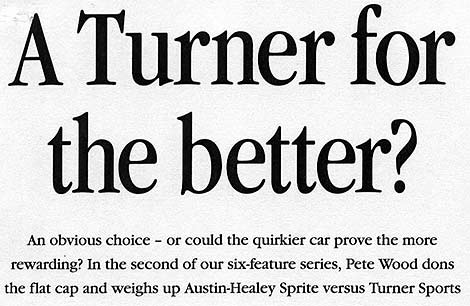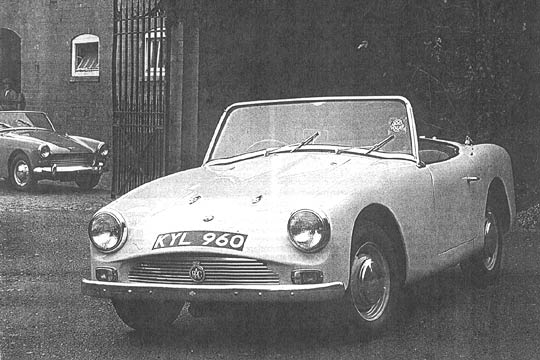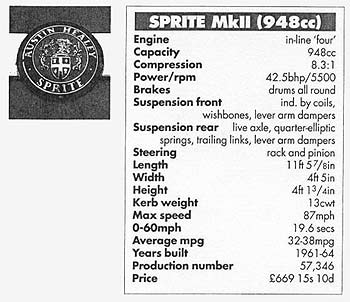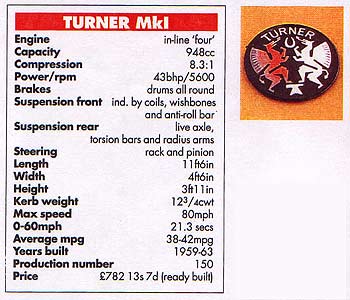| Turner Sports Cars | Articles |
| Turner Sports Cars | Articles |

In the early '60s, there were plenty of small sports cars to choose from. So perhaps there's no surprise that two of them, the Sprite and the Turner Mk 1, born from two very different environments, are so similar in make-up and looks. The Sprite was the obvious choice. It was produced in greater numbers and was a much more familiar sight. But if you wanted a car with that little something extra, that only featured in the result section of magazines such as Motor Sport or Autosport, you'd think about a car such as the lighter, faster, glassfibre Turner.
 The Sprite was a car for the masses, cheap and cheerful. The Turner was for the sportsman who didn't care about looks, the man who thought of racing lines rather than shut lines. Turner man was the duffle-coated weekend spectator who watched Bob Gerard trounce the opposition in a car you could build at home or buy direct from the Wolverhampton factory. The MkII Sprite was an improved and domesticated Frogeye, now with a boot lid, and a proper bonnet to replace the flip front. It was enough to persuade 16,000 people a year worldwide to buy one. Today, little has changed. Thousands still hanker after the Sprite, few of whom would know what a Turner looks like. But if you could drive a good example of each, you might understand why the discerning spend time tracking down one of the 150 or so Turners built. Purchase price was the same, at around £700 -£400 if you assembled the Turner at home. Now, there's a premium on the Turner's rarity, around 20 per cent more than a Sprite in comparable condition. Even so, just £5000 will buy you a cracking example of either car. Mechanically, the Turner and the Sprite are fairly mundane. Both use the running gear from the humble A35. The 948cc A-series engine is a deceptive little beast - sweet-revving, reliable and strong, and capable of giving as good as it gets in the way of bolt-on tuning parts such as twin carbs and a flowed cylinder head. But with under one litre for the four minute pistons to play with, you'll never dust the numerals on the Smiths speedometer much past the 85mph mark in either car. And that's if you've polished the body and are descending a one in three hill with diver's boots on.
The similarity ends with the running gear. The Sprite's A35 guts are clothed in steel, a sleeker, updated version of the earlier Frogeye, to make it resemble the then-unannounced MGB. The grille opening was poached from the Ferrari 250 GT, BMC trying to prove that the Sprite was a scaled-down version of a real sports car to help it through the swinging '60s.
Saving on tooling was critical for profit making. Components from the Frogeye were carried over to the MkII Sprite, announced in May '61. Items such as the sills with the kick-up front were retained. A few alterations were made to the hood and frame, and flick switches replaced the older push-pull type. The MG badged version, the MkI Midget, was identical except for some extra chrome, a different grille and contrasting piping on the seats. It appeared a month after its sibling.  David Lanfranchi, who owns the Sprite, only bought his car a year ago "I love the look of the Frogeye, but its cult status has kept the prices high. A MkII is almost identical mechanically and just as simple to drive and maintain; enormous fun for such a small package. And the later cars don't cost so much because they're not as desirable as the Frogeye. Living in traffic congested London, the Sprite is an ideal car for zipping around from A to B. I can keep up with modern traffic and squeeze past obstructions while the bigger, faster stuff has to wait"
The Turner Mk1 was also a mixture of old and new. John Turner chose to house the mechanicals in a rugged twin-tube ladder frame chassis onto which he mounted a bodyshell in glass-fibre, still relatively new. A steel bulkhead and floorpan were the only rot-prone panels added, necessary for strength and rigidity. Independent coil and wishbone front suspension and, for the live rear axle, radius arms, laminated torsion bars and a Panhard rod better locate the axle and give corner-gripping handling. It was a combination that would see Climax-engined Turners whipping the mass produced cars in the Autosport Production Sports Car Championship in 1960. Bryan Halladay is a veteran rally driver, and competed against the Turner in its heyday with a Herald and other buzz-boxes: "I couldn't believe how the Turner used to trounce everything in its class. On a good day, it even showed a clean pair of heels to bigger-engined cars. "I still do some historic rallying and when I heard this Turner was up for grabs I jumped at the chance of buying it to use in anger. So few turn up for sale that I bought it unseen. The trouble is the car's condition is too good to be abused. By Turner standards, it's mint. But, after a 30-year wait, I don't regret buying it, purely for enjoyment on the highways. Does its kit car status make the car appear lowly? Bryan thinks not "The Turner was better finished than most glassfibre cars available then. The body is thick and, while the finish isn't as good as steel production cars it's just as strong. Building or restoring one is not as difficult as you'd think - far superior to the cheaper Austin Seven or Ford-based tubs which need weeks of finishing." Stick the Turner next to the Sprite and the cars appear very similar at the front. Rumour has it that Turner had inside information about the Sprite's new shape - if that was the case, the company was quick to act on it. The Turner came out three years before its rival. The nose of the Turner slopes down more than its adversary's, affording the driver good forward vision. The front end is a one-piece moulding with a small, externally hinged hatch for engine access. The idea was to get a more streamlined shape while retaining strength. The grille from an Austin van, cut down to fit; door handles are from a Standard 10, and there's an A35 front bumper. A hotchpotch, yes, but it works. The cockpit is snug and basic. The wire-spoked steering wheel launches itself straight out at your chest like a battering ram.
The instrument panel was obviously designed by a sporting driver. Every instrument has been crammed in, but in a sensible layout purely for the driver. All the passenger gets is a hooded light for map reading. The fully carpeted interior helps to keep down the drumming noise at speed over 20mph. A huge switch which looks like a normally floor-mounted starter button sits on the tunnel and acts as a dip switch for the lights, there being little room for anything more than a pair of size eights in the driver's footwell. The fixed seats provide an Italian-style driving position; shorter owners drive with legs stretched while the average person jams into the rear of the bucket frames. The tiny gap between the seats is cleverly used to mount a radio - there must have been a few cricked necks from tuning into Radio Caroline.  The rounded hump of the rear bulkhead sweeps back to merge with the finned rear wings. At the back, it's almost as if John Turner reversed the prototype into a wall and liked the finish. The rear is slab-like with lights and overriders running from top to bottom. The boot opens with an Austin Ruby-style lock and a T handle to reveal the spare. The competition-inspired siting means that wheelchanges can be done in a hurry. There's just enough room for a tow rope and cantilever tool box. There have to be drawbacks though. The finish on the Turner leaves a lot to be desired. Panel gaps vary immensely. Open up the 'attic door' bonnet and the number of pop rivets connecting glass mat to tin would make an ironmonger leap for joy. You wouldn't want to take a Turner to concours events. Rather, wedge yourself behind the wheel and soak up the "what the hell was that" glances. Anonymity is a lot more preferable to "have you seen the cracks in that portable loo?"
The Sprite on the other hand is so well-known that enthusiasts will take an interest. Sometimes too much of an interest: buffs will force their attentions upon you and point out "that shouldn't be on you car. It didn't come out until three months after your car was built." David's car is a case in point: the earliest Spridgets were far too slow by sports car standards and, from October 1962, bigger 1098cc engines were fitted at the factory to boost performance, along with disc brakes. Many early cars have been retrospectively modified with the larder engine and now, 30 years later, it's a rare sight to find a Mk1 Midget or MkII Sprite with the small lump still fitted. The Spridget's steel bodywork is well known by owners and restorers for it ability to bubble and squeak. Mud loves the built-in water traps of the Coker-styled car. The BMC factory's aversion to underseal has a lot to do with it. Instruments are spaced right the way over the dash, which is a lot closer to your chest than the Turner's. The top of the cabin is finished with screwed aluminium strip: you feel as if you're sitting in a beer barrel. The outside wears no door handles but you do get a dash-mounted grab handle. Where the Spridget scores over its rival is in the extra space behind the seats - enough room to plonk an overnight bag or squeeze in a small adult.
On the road, similar mechanically and in size and weight, you'd expect the cars to behave and perform much the same way. In most respects you'd be right - on the straight, there's little to separate the two. Pull the start switch in either one and the engine fires up with that familiar, high pitched, moped-like tickover. Slightly clattery, the A series lump sounds infinitely better when revved. The tiny pockets of waste gases skip down exhaust pipes with not so much the roar of lions, more the mewing of kittens. In either car, whether standard or souped up, the engine will never get you into too much trouble. Wobble the Turner's stubby lever into the non-synchro first and hit the revs. You're not exactly thrown back into your seat with accelerating G forces - it's more of a poke in the chest. Second gear comes up all too quickly but feels twice as useful as its lower sibling. At last, you feel that the 'box can take a bit of stick. All the torque is in the lower rev band but, even after the engine has done its useful work, the revs keep building up with all the freedom of an unleashed greyhound. Don't stick money on it, though - it's unlikely to get you an outright win. The Sprite feels a little more spirited. But this one has larger, 1¼in-bore carbs and nearly 40cc more per cylinder than the Turner. Both need to be pushed to live up to their sports car image. It's right foot down all the way, secure in the knowledge than nothing will go bang. On steep inclines both cars run out of puff quickly and you're torn between the desire to grind the juice pedal into the carpet, or drop a cog, when you'll almost hear the engine say "I'll scream and scream until..." It won't make any difference to your speed, but the banshee wail might frighten the driver of whatever you're attempting to overtake into letting you crawl past.
Find some bends and it's a whole new ball game. The Sprite's short wheelbase is just as twitchy as you'd expect. The back end, with its quarter-elliptic springs, breaks away early, but it is controllable with the accelerator. Back off the pedal and the car comes neatly back into line. It's at its best on the B roads it was designed for; snicking up and down the gears, braking for corners and exiting bends with you right foot hard down. Get a bit excited with the throttle on a hairpin and the mechanical roller skate takes up all of the road with the rear wheels steering. The Turner is even more joyous on sweeping country lanes than the Spridget. Its securely located rear end is less prone to time-wasting, rubber-leaving breakaways. Nudge the wheel and the car jumps into position like a new recruit, although you have to give out the steering orders constantly to get the job done. The Turner behaves like a puppy - eager to please and full of energy. The sweet Moggy Minor rack and steering suit the short wheelbase perfectly. The lighter Turner will just beat a standard Sprite on speed and acceleration. Autotests are cup-collecting days out for the nimble glass-fibre car. Handbrake turns are unnecessary; full lock and a squirt of the throttle and the Turner will do Mansell-style power revolutions all day. With its hood up, the Turner is more noisy than the Sprite. But who drives cars like these with the top up? If it's raining, stop under a bridge. Both cars leak like sieves in a heavy downpour and the wind buffeting off the soft tops when they're up will drive you crazy. But, when it's sunny, not much at the price will beat them for driving fun. Running and maintaining either is a doddle. In the end the choice has to be down to looks or drivability. If you want to enter concours events, go for the steel car. But if you can stomach the ill-fitting glassfibre, the Turner has to be the one for the driver who doesn't mind mud plastered to the wheelarches. |